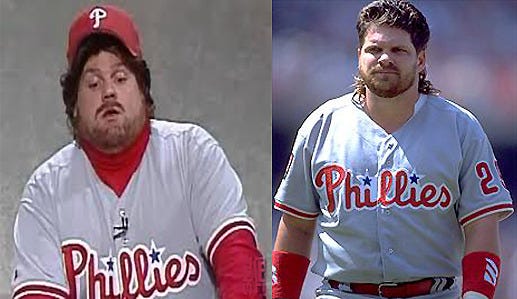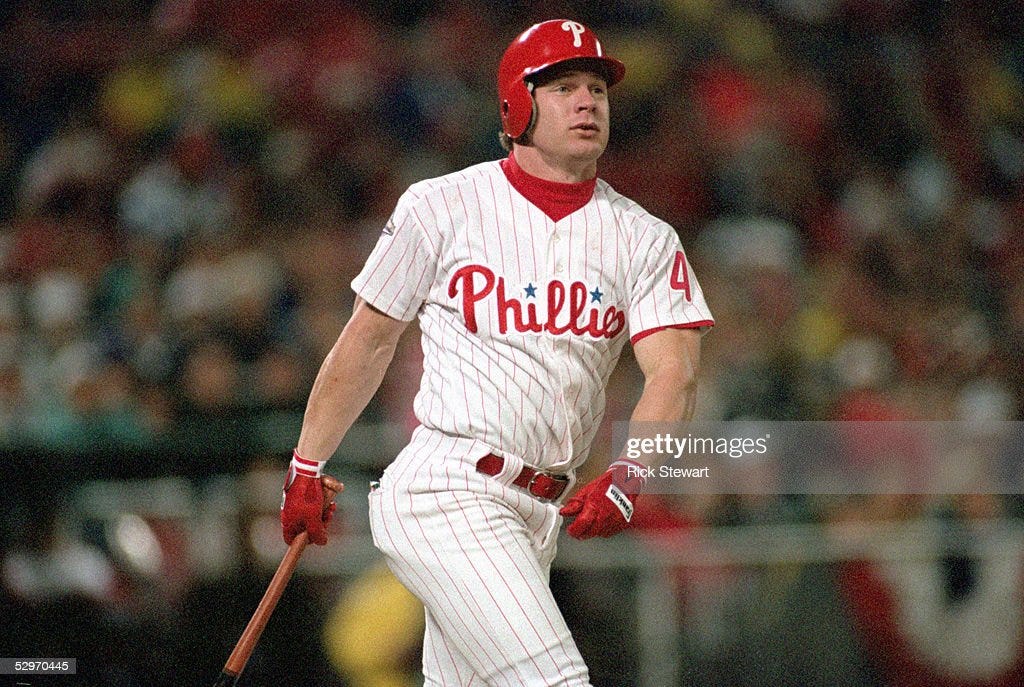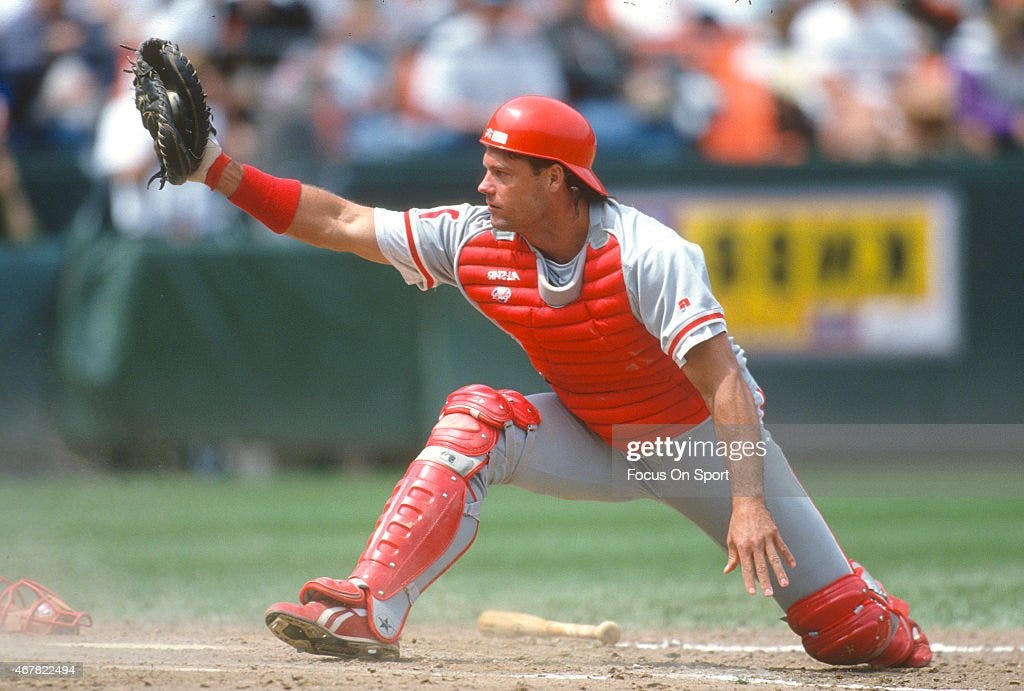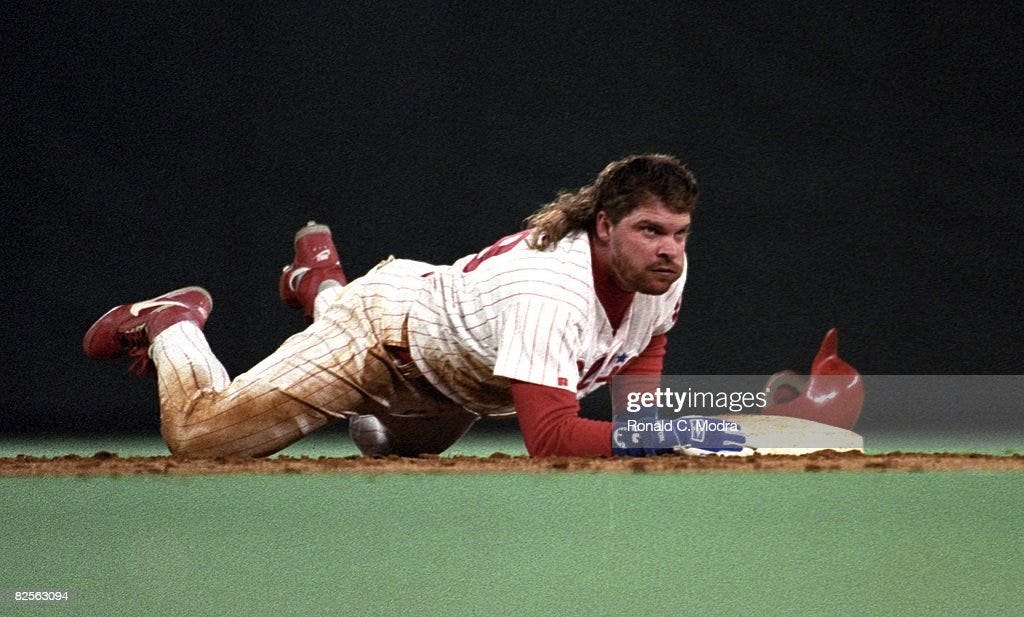
The 1986 New York Mets were probably the most iconic, controversial, entertaining, and dysfunctional team of the 80’s and 90’s. They won 108 games and came back to steal the World Series from the Red Sox with one of the most famous plays in baseball history. And they did it all with an eccentric cast of characters who somehow managed to walk the tightrope between baseball immortality and premature implosion.
Numerous articles, books, and movies have been written about them. My personal favorites are Jeff Pearlman’s The Bad Guys Won and ESPN’s fantastic four-part documentary, Once Upon A Time in Queens, which features a ton of great interviews with most of the key players. I’m not going to attempt to add anything to them— not today anyway.
But it got me thinking. Are there any other teams out there who were close to the Mets when it came to combining on-field success, recklessness, and pure bravado? Only one team came to mind, and it seems pretty obvious in hindsight. The answer has to be the 1993 Philadelphia Phillies.
Nicknamed “Macho Row” in homage to the 1927 New York Yankees’ lineup that was dubbed “Murderers’ Row,” the Phillies featured a lineup of unkempt, schlubby sluggers with five o’clock shadows and mullets. Tobacco juice dripped from the corners of their mouths, and many of them didn’t fit the mold of your typical professional athlete. Chris Farley famously portrayed John Kruk on an episode of SNL, poking fun at the team’s slovenly demeanor, and it never felt like much of a stretch.
I can’t say I ever identified much with them. The whole macho thing has always felt pretty ridiculous to me, with the notable exception of “Macho Man” Randy Savage. (And to be fair, Randy Savage was pretty ridiculous himself, but in the best possible way.) I was a quiet, skinny kid who leaned more towards books than beer bongs. I listened to moody heavy metal in the early 90’s. I imagined the Phillies were more into Foghat, though their unofficial team song was “Whoomp! (There It Is).”
Frankly, the ’93 Phils reminded me just a bit too much of the asshole jocks and rednecks I regularly tried to avoid in the halls of school, so I could never fully get behind them, even as they gained steam through the postseason and became a sort of mini-cultural phenomenon. That said, like any good car crash, they were hard to turn away from.
I won’t spend a lot of time recapping their season highlights and accomplishments. Here’s the Cliffs Notes version.
Philadelphia went from last place in 1992 to first in the NL East in ’93. Few expected them to do so. The Phillies were a heavy underdog in the NLCS, facing the two-time defending NL champion Atlanta Braves, who had added Greg Maddux to their already dominant pitching rotation that season. Philadelphia’s pitching held their own, and the bats did their thing, and the Phillies somehow found a way to upset the Braves, despite some shakiness from their bullpen. Closer Mitch “Wild Thing” Williams’ struggles, in particular, raised a red flag, but they were able to persevere.
That luck ran out in the World Series. Williams came apart in Game 4, surrendering a five-run ninth inning lead when the Phillies had a chance to even the series. Things got even worse in Game 6. Facing elimination and clinging to a one-run lead in the bottom of the ninth, Williams allowed two baserunners before giving up a walk-off home run to Joe Carter for one of the most memorable finishes in World Series lore.
Taken from a distance, nothing about the 1993 Phillies stands out as terribly remarkable. They were a good story, an overachieving team that managed to win their division and ride their success all the way to Game 6 of the World Series, but the record books will tell you that there’s nothing all that uncommon about such a scenario. What made the ’93 Phillies interesting was their collection of parts.
Curt Schilling led a surprisingly good pitching staff that also included former Royal World Series hero Danny Jackson and the stalwart Terry Mulholland. It also didn’t hurt that Tommy Greene, a name largely forgotten in baseball history, had the season of his life in 1993, compiling a 16-4 record with a 3.42 ERA.
Schilling was the headliner though. Philly was the third stop in what had been a fairly uninspiring career up to that point, but it marked the place where Schilling would start to turn things around. He went 16-7 with a 4.02 ERA in 1993, and he won the NLCS MVP award.
From there, he would develop into one of the greatest postseason pitchers baseball has ever seen, though he would never get another chance to prove it in Philadelphia. After leaving Philly following the 2000 season, he earned co-World Series MVP honors with Randy Johnson in 2001, leading the Arizona Diamondbacks to their first championship over the Yankees.
The Yankees would curse his name again in 2004, when he delivered in the famous “Bloody Sock” game against them during Game 6 of the ALCS. Battling through a right ankle tendon injury, he spun a gem to even the series at three games apiece, and set the stage for the Red Sox to complete the only 3-0 comeback in postseason baseball history on their way to their first World Series title in eighty-six years.
If that was all there was to say about Schilling, he would probably be one of the most revered pitchers of his era. But nothing about any of the ’93 Phillies could be that simple. Following his playing career, Schilling spent some time as an analyst for ESPN before he alienated a good portion of the audience spewing right-wing bile. He also defaulted on a seventy-five million dollar loan from the state of Rhode Island when his video game start-up crashed and burned without ever getting off the ground.
Since then, he usually pops up every year to make a big deal over how little he cares about being snubbed by the Hall of Fame, when it’s obvious it bugs the hell out of him. Personally, I think he should be in, because the Hall of Fame is about what you accomplished on the diamond, not the caliber of person you are off of it. That said, I can’t cry too much for him. He’s proven himself time and time again to be an asshole who bullies anyone who disagrees with him and plays the victim whenever he’s criticized for it.
So let’s move on to the lineup, the real “Macho Row.” My first thought when looking at the stats is how unimpressive their power numbers were. Pete Incaviglia, a bulky, statuesque slugger, was the only person on the team with a slugging percentage over .500. He and Darren Daulton led the team with 24 HRs apiece.
This can be deceiving, however. While it’s easy to assume that a bunch of pudgy, unshaven mugs would specialize in hitting the ball over the wall, the ’93 Phillies were a surprisingly versatile offensive machine, starting at the top with Lenny Dykstra. Check out his 1993 numbers:
Dykstra: .305/.420/.482, 19 HR, 66 RBI 44 Doubles, 6 Triples, 37 SB, .902 OPS, 144 OPS+
Now add in the rest of the heart of the lineup.
Kruk: .316/.430/.475, 14 HR, 85 RBI, 33 Doubles, 5 Triples, .905 OPS, 145 OPS+
Daulton: .257/.392/.482, 24 HR, 105 RBI, 35 Doubles, 4 Triples, .875 OPS, 136 OPS+
Dave Hollins: .273/.372/.442, 18 HR, 93 RBI, 30 Doubles, 4 Triples, .814 OPS, 120 OPS+
Incaviglia: .274/.318/.530, 24 HR, 89 RBI, 16 Doubles, 3 Triples, .848 OPS, 125 OPS+
That’s five regular players with an OPS+ well over 100. Throw in Jim Eisenreich, who didn’t exactly fit the Phillies’ slob theme, and you get a sixth. Here’s his ’93 numbers:
Eisenreich: .318/.363/.445, 7 HR, 54 RBI, 17 Doubles, 4 Triples, .808 OPS, 118 OPS+
Eisenreich was the anti-Phillie in a lot of ways. A versatile, athletic outfielder who debuted with the Twins in 1982, he flamed out two years later due to his struggle with Tourette’s syndrome. At the time, most people had never even heard of Tourette’s, and MLB clubhouses were ill-prepared to deal with its challenges.
Eisenreich persevered, however, and was back in baseball in 1987 when the Royals convinced him to give it another try. He was a solid player for Kansas City for six years, before moving onto Philadelphia and providing the Phillies with some much needed likability.
But on the whole, the ’93 Phillies were a complex bunch, to say the least. Take catcher Darren Daulton for example. By all accounts, Daulton was a beloved player to most of his teammates throughout his career. He was even the Phillies’ captain, a responsibility that weighed heavily on him and contributed to his many issues.
And Daulton had issues. He was busted numerous times for speeding and DUI. Later, he was arrested for battery against his wife and spent time in rehab. Eventually, he did clean up his act before dying from a brain tumor in 2015. During that period of his life, he wrote a book titled If They Only Knew, which dealt with the occult and numerology. In it, he recounts his own experiences as a time traveler passing through different dimensions. And this was Daulton at his most lucid!
I’m sure you could write a whole book just on Darren Daulton’s book, but for me the story of the ’93 Phillies will always revolve primarily around two figures— Lenny Dykstra and John Kruk. I wouldn’t say they were diametrically opposed players or personalities. Both of them had the look and good ol’ boy traits that characterized that team, and both were outstanding baseball players in their prime. The rest of their lives, however, paint them as distinctly different people.
Considering the opening of this post, it’s only appropriate that Dykstra, a key figure on the ’86 Mets would also have his fingerprints all over the ’93 Phils. Dykstra made his name for the Mets during their championship season, capitalizing on an early season injury to Mookie Wilson to seize his opportunity.
Undersized and unheralded, Dykstra had a chip on his shoulder and made it his mission to prove his doubters wrong. He was also one of the best clutch players I’ve ever seen. His knack for delivering in big moments earned him the nickname “Nails.” He hit a walk-off home run in Game 3 of the 1986 NLCS against the Houston Astros, one of the greatest moments in Mets’ history. And his leadoff homer in Game 3 of the 1986 World Series helped turn the tide as the Mets battled back from a 2-0 series deficit.
1993, however, was probably his finest single season. He finished second in the NL MVP race to Barry Bonds, and his role as the leadoff man spearheaded the Phillies to their best season in over a decade. He was absolutely integral to their success and overall demeanor. Unfortunately, he might also be one of the worst human beings to ever put on a baseball uniform, which is definitely saying something. No one ever accused ballplayers of being saints.
I feel safe saying that, however. Why? Well, in 2020, Dykstra sued former Mets teammate Ron Darling for libel over a passage in Darling’s autobiography. In it, Darling accused Dykstra of shouting racist slurs at Boston pitcher “Oil Can” Boyd during the 1986 World Series.

The case was eventually dismissed, and the judge ruled that Dykstra’s reputation was so bad that he could not actually be libeled. Can you even imagine how bad your rep must be if it is impossible to libel you? Well, now you know. The answer is as bad as Lenny Dykstra’s.
What’s so bad about it? I don’t have the space to run down his whole rap sheet, but it’s out there if you want more complete details. For now, let’s just say it includes sexual harassment, sexual assault, writing bad checks, grand theft auto, identity theft, filing false financial statements (during his bankruptcy proceedings), indecent exposure, drug possession, steroid use, gambling, fraud, terroristic threats, and kidnapping. Wow.
Not surprisingly, he’s good friends with Charlie Sheen. He also later claimed that he hired private investigators to dig up dirt on MLB umpires during his fantastic 1993 season, in order to leverage more favorable counts during his plate appearances. If true, though I’m not sure I would believe anything Dykstra says without considerable evidence, then it is no coincidence that he drew 89 more walks than the previous season and led the NL in that category in ’93.
Now compare him to John Kruk, the Phillies’ stocky first baseman. If Dykstra was the devil on the team’s shoulder, then Kruk might have been the angel on the other one. Keep in mind, we’re talking about the ’93 Phillies, so don’t expect him to actually look like an angel. A clean-shaven John Kruk in white robes would be an obscenely unnatural sight, but unlike Dykstra, everything under Kruk’s gruff exterior appears to reveal a genuinely good guy.
Sure, nothing about his physique screamed pro athlete. If not for his recognizable mullet and scruff, he could probably pass for any other schlub walking down the street in Philadelphia. But looks can be deceiving. For example, John Kruk hit 34 triples in his MLB career. That’s only four less (and over a much shorter time) than Ken Griffey Jr., a first ballot Hall of Famer and one of the most gifted athletes to ever lace up a set of cleats. The speedy Dykstra only had 43.
Here is a look at Kruk’s career statline:
.300/.397/.446, 100 HR, 592 RBI, 1,170 H, 582 R, 199 Doubles, 34 Triples, 58 SB, .842 OPS, 134 OPS+, 25.1 WAR
Kruk is often viewed by fans in a comical light. Part of this is probably due to his body type, but most of it has to do with his personality and the way he played the game. Kruk was a player who enjoyed a good laugh and didn’t take things too seriously, though his numbers prove that he was absolutely a legit major leaguer.
Of course, his most famous highlight had nothing to with athletic performance. It came during the 1993 All-Star Game, when he stepped up to the plate against fireballing Mariners pitcher Randy Johnson. Johnson’s first pitch got away from him and sailed inside over Kruk’s head. Kruk bailed out of the way and fell to the dirt, then pretended to have a heart attack. He then flailed weakly at the next two pitches and struck out in comical fashion, having no desire to push his near-death experience any further.
My favorite Kruk story comes from earlier in his career when he was still with the San Diego Padres. Kruk broke out with the Padres in 1987, hitting .313 with 20 HR and 91 RBI. Following the season, he played winter ball in Mexico and when he returned for Spring Training, the FBI was waiting for him.
It turned out that Kruk’s roommate in San Diego, an old acquaintance from his hometown in West Virginia, had been robbing banks for the last year. Kruk had no idea, though the more he thought about it, the more red flags were raised by his buddy’s insistence on always picking up the tab whenever they went out. The guy always had cash on hand, far more than the professional baseball player— Kruk was making around $60,000 a year at that point. Part of him suspected his roommate was dealing drugs, but since he never saw anything suspicious, he shrugged it off.
Now the FBI was showing him surveillance photos of his pal robbing a bank. Even worse, with the Feds on his trail, his somewhat unstable, survivalist “friend” had gone on the run, convinced that Kruk had ratted him out.
Fearing for his life, paranoia cratered Kruk’s 1988 season. Constantly looking over his shoulder, he couldn’t fully concentrate on his play until his roommate was finally arrested that September. After a few months in prison, his pal reached out and apologized. Kruk told him not to worry about it, to focus on getting his own head straight, and told him to reach out when he was released. Unfortunately, he took his own life before Kruk could reconnect with him.
That story doesn’t have a happy ending, but Kruk’s own struggle against adversity did. During Spring Training in 1994, as the Phillies gathered to defend their NL pennant, Kruk was hit by a wild pick-off throw from Mitch “Wild Thing” Williams (shocker) during a team scrimmage. Diving back into first base, the ball hit Kruk squarely in the junk. It hit so hard that it broke his protective cup.
As bad as that sounds, and it does sound painful, it turned out to be a lucky break for Kruk. While treating it, team doctors discovered the early signs of testicular cancer. His right testicle was removed and he underwent radiation treatment, motivated by the unlikely goal of returning to action for the Phillies’ home opener on April 11th.
Amazingly, he did just that, despite receiving a radiation treatment that morning. He knew it was going to be a big moment. Legendary Phillies tough guys like Larry Bowa and John Vukovich were in tears, and Veterans Stadium was the loudest he’d ever heard it, even though they’d just played in a World Series roughly six months earlier.
Kruk did his best to block out the fanfare (an impossible task) and focus solely on the game. Stepping to the plate for the first time, the crowd stood on their feet and roared supportively in nervous anticipation. On the surface, it was a rather insignificant opening day at-bat, but in reality, it meant so much more than that.
Kruk was up to the moment. Knowing his timing would be off and expecting a fastball, he swung early and roped a double into the gap in right-center, scoring Mariano Duncan from first. The crowd lost its damn mind.
No championship was on the line. No records were being broken. No Hall-of-Famers were involved. It was just one of those truly beautiful moments that makes baseball so special.
Not bad for a schlubby, lovable everyman like Kruk, and living proof that even Macho Row had a heart.
Thanks for reading Powder Blue Nostalgia. What are your memories of the ‘93 Phillies? Got a candidate for an even more dysfunctional team? Leave a comment below, and as always, please subscribe and share. We’re building a nice reader base, but I’d love to see the numbers explode!






This was the team that made me fall in love with baseball. You say they reminded you of "asshole jocks" at your school, but to me and my classmates, you couldn't be more wrong. Every other team, it seemed, featured egotistical jerks who had lost their love of the game. Those Phils reminded us of our dads' buddies - crude but authentic. Thanks for writing about them!
John Kruk authored one of the best baseball quotes of all time. Admonished by a woman who saw him smoking and expressed disbelief a professional athlete would do such a thing, he responded, "I ain't an athlete, lady, I'm a baseball player." Anyway, I really liked the '93 Phils, since both the Braves and Blue Jays were already old hat and seemed like a bunch of rich country club kids.